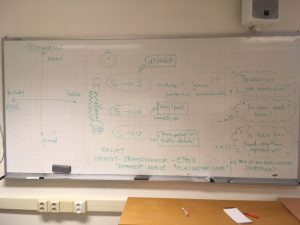As a novice researcher you may be wondering why some scientific articles are easier to read and understand than others. Or you are daunted by the amount of literature on your subject and aren’t sure what to include in your literature review. Or you want to know why some people do not accept scientific evidence when it matters, and what you can do about it when communicating your research. SEKOM offers a PhD-level course where you can get answers to these questions.

If you are a researcher, chances are you have been guilty of at least one of these on at least one occasion:
- Hiding your most important message in the depths of your text or presentation, mentioning it in a minor footnote – or not expressing your main message at all. You’ve given the reader all the facts so he/she should be able to figure out what your message is, right?
- Getting annoyed (or just uncomfortable, depending on your temperament) when someone asks you “What’s your main argument? What’s the one-liner?” Because how could you possibly do that – it’s too complicated, right?
- Scaring away a non-expert who is genuinely interested in your research – either by saying “oh, it’s too boring / theoretical / technical” or by rattling off a dense scientific abstract full of technical terms. Because that’s how it is – you work on something so remote from everyday life that it’s only natural for non-experts to not understand. It’s strange, actually, that anyone outside of academia would even be interested in what you do….right?
Does that sound familiar? If it doesn’t, think again – given the conventions of academia, it is quite natural to think like this. Unfortunately, if you want to increase your chances of getting published, if you want to connect with non-expert audiences, or attract the attention of the relevant user group, thinking like this can have negative consequences.
The good news is that, as an NTNU researcher, you can do something about it. Since 2014 we have been running a highly popular PhD-level course entitled “Communicating science in journals and to the general public” (HFEL8000), which helps you tackle these, and many other, aspects of scientific communication.
The course is built around the crucial difference in communicating your research to different audiences and for different purposes. We look both at the bigger picture (what do you want to communicate, to whom, and why?) as well the technical details (what are the specific guidelines, principles, or conventions you need to follow?). The aim is to make you realize that you have something to say to a range of audiences – not just “your people” in your expert bubble. We help you identify your audiences and the ways of connecting with them effectively – so that you are heard and appreciated. The language of the course is English, since the primary focus is on communication within the international scientific community (and since the course participants tend to be an international crowd); however, Norwegian is included when communicating with local audiences.

The HFEL8000 course is taught by an interdisciplinary team covering a range of relevant areas, such as developing your communication strategy, NTNU branding, communicating science through visuals, academic writing, communicating science in the post-truth era, writing successful funding applications, and communicating science as a deeply human story. We aim for tangible course outcomes for each participant – see for example this recent blog post on Forskning.no.
Take a step towards effective communication of your research – sign up for the course! We look forward to working with you.
